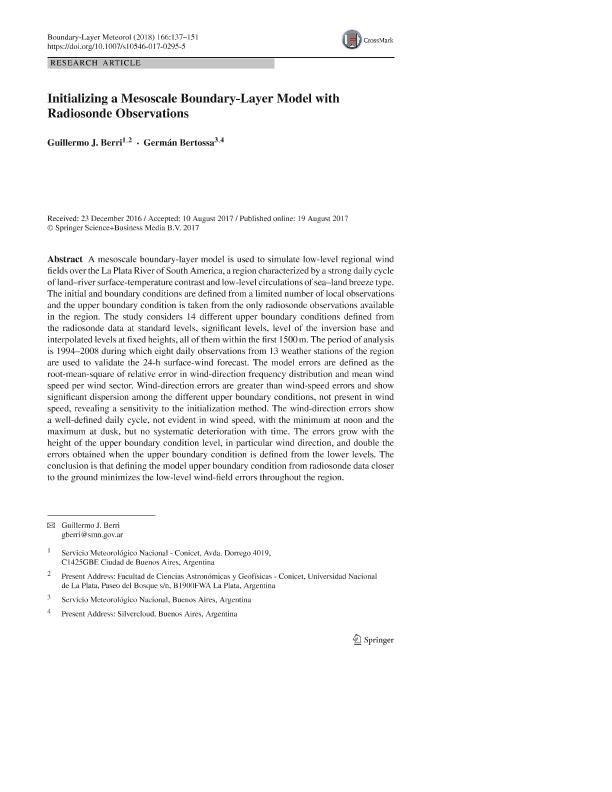Mostrar el registro sencillo del ítem
dc.contributor.author
Berri, Guillermo Jorge

dc.contributor.author
Bertossa, Germán
dc.date.available
2021-04-14T15:13:40Z
dc.date.issued
2017-08
dc.identifier.citation
Berri, Guillermo Jorge; Bertossa, Germán; Initializing a mesoscale boundary layer model with radiosonde observations; Springer; Boundary-layer Meteorology; 166; 1; 8-2017; 137-151
dc.identifier.issn
0006-8314
dc.identifier.uri
http://hdl.handle.net/11336/130027
dc.description.abstract
A mesoscale boundary-layer model is used to simulate low-level regional wind fields over the La Plata River of South America, a region characterized by a strong daily cycle of land–river surface-temperature contrast and low-level circulations of sea–land breeze type. The initial and boundary conditions are defined from a limited number of local observations and the upper boundary condition is taken from the only radiosonde observations available in the region. The study considers 14 different upper boundary conditions defined from the radiosonde data at standard levels, significant levels, level of the inversion base and interpolated levels at fixed heights, all of them within the first 1500 m. The period of analysis is 1994–2008 during which eight daily observations from 13 weather stations of the region are used to validate the 24-h surface-wind forecast. The model errors are defined as the root-mean-square of relative error in wind-direction frequency distribution and mean wind speed per wind sector. Wind-direction errors are greater than wind-speed errors and show significant dispersion among the different upper boundary conditions, not present in wind speed, revealing a sensitivity to the initialization method. The wind-direction errors show a well-defined daily cycle, not evident in wind speed, with the minimum at noon and the maximum at dusk, but no systematic deterioration with time. The errors grow with the height of the upper boundary condition level, in particular wind direction, and double the errors obtained when the upper boundary condition is defined from the lower levels. The conclusion is that defining the model upper boundary condition from radiosonde data closer to the ground minimizes the low-level wind-field errors throughout the region.
dc.format
application/pdf
dc.language.iso
eng
dc.publisher
Springer

dc.rights
info:eu-repo/semantics/openAccess
dc.rights.uri
https://creativecommons.org/licenses/by-nc-sa/2.5/ar/
dc.subject
BOUNDARY-LAYER MODEL
dc.subject
FORECAST ERRORS
dc.subject
INITIALIZATION DATA
dc.subject
LOW-LEVEL WIND FIELDS
dc.subject
RADIOSONDE OBSERVATIONS
dc.subject.classification
Meteorología y Ciencias Atmosféricas

dc.subject.classification
Ciencias de la Tierra y relacionadas con el Medio Ambiente

dc.subject.classification
CIENCIAS NATURALES Y EXACTAS

dc.title
Initializing a mesoscale boundary layer model with radiosonde observations
dc.type
info:eu-repo/semantics/article
dc.type
info:ar-repo/semantics/artículo
dc.type
info:eu-repo/semantics/publishedVersion
dc.date.updated
2021-04-12T16:18:59Z
dc.journal.volume
166
dc.journal.number
1
dc.journal.pagination
137-151
dc.journal.pais
Alemania

dc.description.fil
Fil: Berri, Guillermo Jorge. Universidad Nacional de La Plata. Facultad de Ciencias Astronómicas y Geofísicas; Argentina. Consejo Nacional de Investigaciones Científicas y Técnicas. Centro Científico Tecnológico Conicet - La Plata; Argentina. Ministerio de Defensa. Secretaria de Planeamiento. Servicio Meteorológico Nacional; Argentina
dc.description.fil
Fil: Bertossa, Germán. Ministerio de Defensa. Secretaria de Planeamiento. Servicio Meteorológico Nacional; Argentina
dc.journal.title
Boundary-layer Meteorology

dc.relation.alternativeid
info:eu-repo/semantics/altIdentifier/doi/http://dx.doi.org/10.1007/s10546-017-0295-5
dc.relation.alternativeid
info:eu-repo/semantics/altIdentifier/url/https://link.springer.com/article/10.1007/s10546-017-0295-5
Archivos asociados
